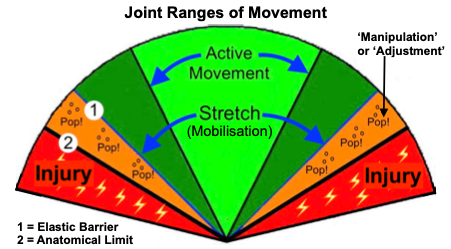Chiropractic manipulation or adjustments use controlled directed force to release joint locking, helping the joints to find their more natural alignment. The adjustment improves blood circulation to help the healing process and nerve stimulation to inactive or unresponsive muscles, whilst reducing the nerve stimulation to over-active muscles, all of which can result in weakness and poor joint stability if not treated.
Aligning the joints – ‘Putting bones back into place’
Muscle contraction around a joint may pull it out of its neutral, aligned position, so the bones appear “out of place”. Chiropractic adjustment releases the locking in the muscles, or joint capsules, allowing the body to find it’s neutral position. Certainly clients can feel more aligned sometimes after treatment and often remark that they feel taller, less stooped and can move more freely.
The client or patient needs to be as relaxed as possible and learn not to hold the breath or tense at the moment of the adjustment. For a Chiropractor to adjust the joint:
- The joints need to be moved to the comfortable limit of stretch or mobilisation, to the elastic barrier to remove any slack in the joint.
- The joint is moved in a quick split-second stretch beyond the active range, but not beyond the anatomical limit. The joint ‘crack’ with the gas release causes a neurological response, which creates a wave of relaxation within the joint tissues, thereby restoring mobility.
If ligaments or joint capsules have been physically shortened over a period of time, they adapt a new ‘habitual’ degree of tension. After adjustment the joint will tend to stiffen back into it’s ‘habitual’ tension pattern, although usually not to the same extent as before the adjustment. In time, with repeated adjustments and care not to avoid habits in our daily lives that stress the joint, it will improve.

Joint manipulation: relaxing the surrounding muscles
Chiropractic adjustment helps further to balance the muscles surrounding a joint: some muscles may be over-tight or in spasm, and adjustment loosens the muscles, improves blood circulation, removes excess toxins and lactic acid where the tightness has resulted in a lack of oxygen reaching the muscles. Others may be inactive or unresponsive, and both result in weakness and poor joint stability. Treatment reduces the nerve stimulation to the over-responsive muscles, whilst improving the responsiveness of the under-active muscles.
The focus of Chiropractic treatment is to reduce the associated muscle spasm, restore joint mobility and decrease the inflammation to allow the injury to heal without more permanent joint or muscle tightness setting in.
Long-term effects of injury
Scar tissue forms like a glue to bond the torn tissue back together, but can create inflammation or swelling. Scar tissue will continue to form past six weeks and up to a year after the event in severe back injuries. Chiropractic treatment soon after an injury can help reduce the excess muscle spasm and joint locking and helps to minimize the swelling and inflammation. Further treatment can help to break down the excess scar tissue to hep the joints and muscles regain their normal flexibility and reduce the chance of further injury. Whilst exercise is appropriate for breaking down scar tissue once the injury has healed, it may further irritate the torn fibres during the initial stages, just as equally being too inactive can cause further muscle spasm. Chiropractors especially are very keen on unlocking the tight joints with manipulation if appropriate, releasing the muscle spasm with deep soft tissue massage, keeping active in a manner that helps the injury and promotes healing and relaxing the back.
Joint settling after Chiropractic treatment
The ‘pop’ sound of a joint adjustment is usually clearly defined. After an adjustment it takes about 20 minutes for the joint gases to reabsorb (‘refractory period’), whilst the pressure in the joint returns to normal. During this time you will not be able to elicit another joint pop. After this it may be possible to pop the joints again, although it is not advisable straight away.
Tailoring treatment to the individual
Although a principal Chiropractic treatment method is joint adjustment or manipulation, there are a wide variety of treatments used, making it effective for all ages or for those who require a more gentle approach. The art of Chiropractic is to learn how to tailor the treatment to each individual and even with experience, understanding how each client responds to treatment is a learning curve. Click here to hear from previous Chiropractic patients.

Main benefits of Chiropractic treatment
- Support and protect the muscles
- Help muscles loosen up and lessen the pain
- Reduce inflammation
- Help break down excess scar tissue in the muscles and ligaments to help restore normal flexibility
To see for yourself what Chiropractic can do, please don’t hesitate to contact the Back Care Clinic.
Joint Ranges of Movement
During a joint adjustment the joint is taken beyond the elastic limit (1) into the orange ‘paraphysiological range’ which reduces the pressure temporarily, and causes the joint sounds as gas bubbles release. This can greatly increase the mobility in the joint, in a way that joint mobilisation or stretching can’t achieve.
Active Movement: The amount you can move yourself, by muscular action.
Mobilisation or Passive Stretch: The amount of movement when a joint is stretched, or for example in physiotherapy, yoga or by your Chiropractor up to the elastic barrier.
Adjustment/Manipulation: Motion achieved during a Chiropractic adjustment or manipulation, with or without an audible release beyond the Elastic Limit (1) into the paraphysiological space
Strain or Injury: beyond the normal Anatomical limit (2), which can damage ligaments and tear the surrounding joint capsule, muscles or ligaments, giving acute pain or inflammation, as well as muscle spasm around the injury.

Joint sounds
Joint manipulation (or adjustment) is moving the joint just beyond the elastic range shown above, which is different from just ‘mobilising’ or stretching, where usually no joint sounds occur.
There are two different types of joint sounds: the clearer, louder joint ‘pop’ with a Chiropractic adjustment, and the repetitive joint rubbing or grating, creaking, ‘crepitus’ sounds.
What causes joint sounds like clicks and popping?
Joints are lubricated by synovial fluid which contains oxygen, nitrogen and carbon dioxide, helping to ‘oil’ the joints and keep them moving smoothly. It also provides nutrients to help maintain healthy joint surfaces. It is a volatile and is held as a fluid under normal joint pressure. The ‘crack’ or ‘pop’ sound occurs during a joint manipulation. It can happen naturally, or we can get into habits of doing it ourselves, for example if we click our own fingers.
This is of course a simple explanation, and in many ways, we still don’t know exactly what causes the sounds. Below are two theories as to how the popping sounds are created:
Bubble Formation theory
As the joints are stretched, a vacuum is created, and this changes the synovial gases from fluid into tiny gas bubbles. As the vacuum increases within the joint fluids, the bubbles come together until they form one sizeable bubble, which then bursts with a “pop”. This is painless and happens in a split second. Have you ever used a vacuum bottle pump to save wine from oxidation? You can see how bubbles form in the wine if too much air is extracted, and there is a ‘pop’ when you remove the stopper.

Suction Cup Release theory
A synovial fold in a joint is believed to behave very similarly to a suction cup, as joint surfaces are held together and the negative pressure already exists. If an elastic cup is pushed down onto a polished surface, it removes all air. As the cup is pulled away it stretches. The air is subjected to an increase in volume, and the pressure holds the edges of the cup onto the surface until it reaches its elastic barrier. A ‘crack’ sound is heard as the edge of the cup lifts, and air quickly rushes in to the space to equilibrate the vacuum creating a sound wave.

Be aware that joint sounds don’t always happen. Some people’s joints click more loudly than others and some just don’t seem to give any audible ‘pop’. This can also happen if the joints are very tight or if there is acute muscle spasm around the joint. So please don’t feel cheated if your joints don’t crack as you’ve seen on YouTube videos! With some people the joints just don’t sound, but they have still been released and stretched effectively to restore their movement.
Other joint sounds
It’s important to distinguish between true joint pops from Chiropractic adjustment and other sounds that may come from joints, but which indicate other things.
Crepitus, grinding, graunching, grating, creaking, and crunching are all words to describe the repeated sounds that happen during the rubbing of tendons, ligaments, muscles or scar tissue. For example, this could manifest itself as ‘noisy’ shoulders every time the arms are stretched, or when getting up from squatting or sitting, especially after periods of inactivity.
Inflammation or joint injury
If there is swelling or excess fluid in a joint, movement can cause sounds. A rotator cuff shoulder injury, for example, tends to creak every time the arm is raised or moved though a specific range or movement.
Repetitive clicks or snapping
Caused by misaligned connective tissue or even nerves. For example, the ulnar nerve can slip in and out of its ulnar groove each time you flex and extend your elbow.
Joint rubbing through loss of cartilage
As arthritic joints lose their smooth cartilage there can be scar tissue in the joint, or the bones rub together on a rougher, more unstable surface.
Ligaments
Ligaments are fibrous tissues that connect two bones at a joint. Tight ligaments are prone to popping when they are suddenly moved, which sometimes results in short-lived pain in the area.
Tendons
Tendons are fibrous tissues that connect muscle to bone and can also cause popping noises around a joint. This is most commonly found in snapping hip syndrome which causes a snapping sensation when the hip is flexed and extended.
Scar tissue
After joint injury or surgery, scar tissue, known as adhesions, is formed by the ligaments which are more prone to popping and cracking. Common examples are shoulder rotator cuff injuries and fibrous adhesions in the lungs, which can give a rasping breathing sound.
Joint sounds that may require treatment
Ripping or tearing noises, especially if heard during a fall or accident, could be a sign of a torn muscle, ligament or tendon, particularly if this is accompanied by pain, swelling or bruising.
Similarly, if you hear a “clunk” or louder pop with a feeling of movement of a muscle or ligament over a bone, especially if disconcerting and repetitive, you should seek treatment. This type of sound is commonly heard in the shoulder, as the tendons ‘snap’ when the arm is raised, or on hip flexion or outward rotation as the muscles roll over the hip.
If you have any concerns or questions about joint sounds, please contact us at the Back Care Clinic.
